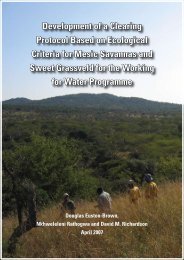Metsi Consultants - DWA Home Page
Metsi Consultants - DWA Home Page
Metsi Consultants - DWA Home Page
You also want an ePaper? Increase the reach of your titles
YUMPU automatically turns print PDFs into web optimized ePapers that Google loves.
Report No 678-F-001<br />
METSI CONSULTANTS: SUMMARY OF MAIN FINDINGS FOR PHASE 1 DEVELOPMENT<br />
reverse this trend. Geomorphological impact would be at most a slight reduction of inundation of wider, macrochannel<br />
elements (bars, benches and mini-floodplains) that would reduce the exchange of sand, nutrient-rich fine<br />
sediments and organic matter between rivers and banks.<br />
Table 5.1 Hydrological summary for the Minimum Degradation Scenario. Shaded sites<br />
represent reaches immediately downstream of Phase 1 dams. MCM a -1 = millions<br />
of cubic meters of water per annum.<br />
IFR Site Historical MAR Minimum Degradation Scenario<br />
MCM a -1 MCM a -1 As % of MAR<br />
1 87 51 59<br />
2 554 366 66<br />
3 774 436 56<br />
4 1572 866 55<br />
5 1924 1194 62<br />
6 3330 2171 65<br />
7 355 231 65<br />
8 592 397 67<br />
Water quality changes are difficult to predict without details of the chemical and physical characteristics of the<br />
outflows, but in general it is considered that there would be mild increases in dissolved nutrients and suspended<br />
solids in the river water. Thus, in quiet waters where the suspended solids could settle out, an increase in the<br />
occurrence of algae is expected, and in faster-flowing areas, the water is expected to be slightly more turbid than<br />
under present-day conditions.<br />
The channel and inundation changes described above would affect the riparian vegetation, whilst both these and<br />
the water quality changes would impact aquatic plants and animals. There would be a negligible to low decrease<br />
in the abundance of annual plants, shrubs and trees growing at all levels up the banks. The most important social<br />
use of these is for medicines, while other uses listed are firewood, traditional attire, handicrafts, food, building<br />
construction, grazing, ropes, yokes, bank stabilisation, fodder and grazing. Their loss may be partly countered by<br />
a very mild increase in grasses and sedges in the same areas, and of large water plants (macrophytes) in the<br />
river itself. These kinds of shifts in plant communities, including the proliferation of algae, would be most obvious<br />
closest to the dams, diminishing downstream, with a change in abundance of only 0-5% predicted for IFR<br />
Reaches 5 (Whitehills) and 8 (lower Senqunyane). IFR Reach 6 (Seaka Bridge) differs from this trend, with a<br />
higher (10-20%) shift from shrubs and trees to sedge and grasses, which is mainly a reflection of the different<br />
shape of the river channel in this reach.<br />
The changes in river-bed substrata, temperature and water quality would encourage a mild shift in aquatic<br />
invertebrate communities from fast-water to slow-water species. Conditions would be slightly more conducive for<br />
aquatic worms, the intermediate snail hosts of liver fluke parasites in domestic livestock, and the blackfly pest that<br />
targets poultry.<br />
The major impact on fish would be confined to the Matsoku River, where the simple presence of the weir would<br />
disrupt movement of fish along the channel and might affect spawning and migration cues. It is predicted that<br />
there would be a moderate to severe (11-50%) decrease in abundance of the Maluti Minnow and a severe (40-<br />
80%) decrease in trout numbers. Other fish species do not occur in the Matsoku River upstream of the waterfall<br />
26

















